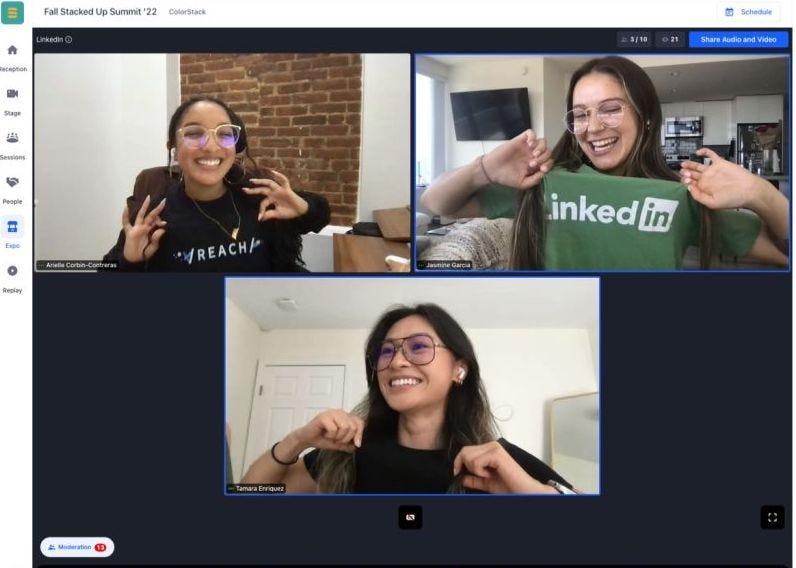Hello!
I’m excited to be back after my extended summer break. Especially as there are so many new subscribers. Welcome! We’re kicking off in style with our Q&A guest, Jehron W. Petty.
Jehron is the founder and CEO of ColorStack, a non-profit collegiate organisation for Black and Latinx Computer Science students. Jehron founded ColorStack after graduating with a Computer Science degree from Ivy League university Cornell in 2020. He turned down a full-time job at Google to pursue it. Today, ColorStack has almost 2,000 members, 6 full-time employees, and over $2.5 million in total funding. And they’re just getting started.
You founded ColorStack to increase the number of Black and Latinx Computer Science graduates launching technical careers. Why did you decide to dedicate yourself to this mission?
I was frustrated with the lack of representation within the opportunities I was taking advantage of in college. Whether it was my internship, the teaching assistant course staff, or project teams, I hated being the only Black person in the room. So I started mentoring my peers in my own time, eventually building a club to scale those efforts. That club ended up helping triple Black and Latinx CS enrollment. For me, accomplishing something similar at a national scale was the logical next step. I knew we had much more potential as a collective than barely scraping by on our own. I wanted to release this untapped potential.
How did you get into Computer Science?
Computer Science appealed to me because writing code is problem-solving. You have an objective you're trying to achieve, and each line of code builds towards that solution.
I've been a problem solver all my life. Growing up, I was constantly dissatisfied with the status quo and motivated to solve any problem I noticed around me. I became very entrepreneurial over time but needed a specific study area to focus on in college. I had heard that some of the most prominent entrepreneurs didn't study business in college. Instead, they studied some form of engineering and learned business along the way.
ColorStack describes itself as a tech non-profit. Can you unpack that definition for us?
It's two-fold. We're a non-profit serving folks in technical careers and leveraging technology to fulfill our mission as best we can.
We're a national community, so we have to find ways to deliver our value propositions virtually. We use different software to host events, create avenues for communication, track our data more efficiently, and even think about ways to give our students direct opportunities to build technology skills. Our vision is to create a world where Black and Latinx technologists are at the forefront of innovation.
You worked at a range of top tech companies before stepping into the non-profit world. How did those experiences shape your approach to building ColorStack?
Software development has many underlying principles that are relevant to other disciplines. Whether it's testing hypotheses, thinking about user experience, or building for scale, I've approached building ColorStack with this software mindset. It's paying off: we've achieved greater impact at a fraction of the cost compared to other non-profits in our space. And that's because we are flexible in executing and adapting to changing market conditions.
ColorStack has such a powerful mission. What's been the highlight of your journey so far?
The highlight is learning about the student success stories, big and small. It could be someone deciding to stick with Computer Science or meeting their best friend because of us. Every week, a story reminds me of why I chose to build ColorStack. It's much more fulfilling to help thousands of students achieve what I did and more as Computer Science students than to achieve it myself.
How can the tech and non-profit sectors come closer together?
The tech industry should invest in building solutions for non-profits with its excess capital and resources. Many non-profits don't have the time or resources to execute on their mission fully, but that's exactly what the software world has been doing for decades—finding cheaper and faster solutions to problems!
I would also love to see more non-profits building software. The biggest issue is compensation: non-profits can't even come close to tech salaries. But both sides need to find ways to make the experience worthwhile for a software engineer. Like sabbaticals. I've seen some tech companies give employees six months to work at a non-profit.
Which three books have had the most significant impact on you as leaders and why?
The Ideal Team Player by Patrick Lencioni — In my time building ColorStack, I've learned that the team behind your product or service is critical to its success. The "wrong" hire can set you back months, even years.
Essentialism by Greg McKeown — Founding an organization pulls you in so many directions, so prioritization is key. It's better to do one thing 100% than ten things at 10%. Essentialism shows you that it's possible.
The Power of Habit by Charles Duhigg —Thinking takes time. For you, your team, and your customers. The more habits you can create, the higher output you can yield from a process.
Questions for Jehron? Catch him on Twitter or 📧 jehron@colorstack.org
Thanks so much for reading!
Lauren



